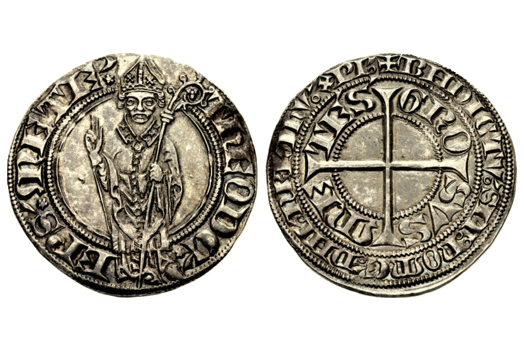
about ancient nomos
Ancient Nomos Art is a museum of galleries exhibiting ancient coins and ancient mint maps. The coin gallery displays the diverse art and history of hand-crafted ancient Greek, Roman, Byzantine, Persian and Medieval coinage. The ancient mints mapping gallery features Greek, Roman, Byzantine, Asia Minor and Medieval mint city regions and territories. Visitor's are welcome to explore, study and enjoy Ancient Nomos Art.

Medieval, Metz – 1365 AD
Thierry Boppard
From Ancient Galleries

Obverse: Thierry V standing facing, raising hand in benediction and holding croizer.
Reverse: Double row of legends surrounding large cross pattée in center.
LEGEND
Obv: ThEODЄ’• EPS’• METE’• with rosette (cinquefoil) stops in legend. Thierry V de Boppart as Archbishop wearing episcopal regalia standing facing, raising right hand in benediction and holding croizer in left hand. Rev: Outer legend: BHDICTV’• SIT : nOmЄ’• DHI’• nRI’• IHV’• XPI’•; inner legend: GRO SVS mE TES, all within three beaded circles; large cross pattée in center.
The city of Metz is located at the confluence of the Moselle and the Seille rivers in northeast France. Metz is a city with a long and rich history. The city was an important Gallo-Roman city, becoming a strong hold for Rome in the north. Following the decline of Roman influence, the Merovingian kings of Francia established Metz as their capital of the Austrasia kingdom. Subsequently, the city became the birthplace of the Carolingian dynasty. Metz has a rich 3,000 year history. Metz is steeped in Romance culture, but is also strongly influenced by Germanic culture because of its location. In 1365, Thierry V de Boppart traveled with the emperor of France to the palace of the popes in Avignon. On August 13, 1365, Thierry V was appointed Bishop of Metz, by Pope Urban V to replace John III of Vienna. He moved in November of 1365 and became archbishop of Metz. The coin above is an example of late medieval western European gros, which is a silver multiple of the penny, issued by the regional mint of Metz for circulation in the surrounding kingdom. In this case, the archbishop of Metz in Lorraine had minting authority and consequently issued coins in the name of the successive archbishops, of which Thierry V is assigned the coin. The obverse depicts a full figured image of Archbishop Thierry V standing and facing forward. Some believe the image might also be a symbolic reference to St. Stephen (Étienne), patron saint of Metz. He is seen wearing his episcopal regalia, with right hand raised in benediction. He holds upward a crosier-staff in his left hand, which during medieval times signified a bishop’s connection to the pastoral shepherds of early Christianity. Interestingly, Thierry V received a reliquary bust of Charles IV on Palm Sunday in 1376 AD, which they say contained the relics of St. Stephen. From that time onward, St. Stephen would be worshiped as the Metz patron saint. The coins reverse displays a centered cross surrounded by the Latin abbreviation, BHDICTV’• SIT: nOmЄ’• DHI’• nRI’• IHV’• XPI’•, translated to mean “Blessed be the name of our Lord Jesus Christ.” The inner legend: GRO SVS mE TES, translated to mean “Gros of Metz,” to signify the coin denomination and mint location. The typical silver gros coinage would have circulated throughout the provincial region of Lorraine, parts of the Rhineland, and into the far eastern areas of medieval France. The provincial coin denominations maintained close standards that were based on the monetary system established by the royal Kings of France. At the end of the Thierry V de Boppart’s episcopate, he reportedly sold the Metz mint production facility for 4,000 francs to the royal kingdom of France on 25 September 1383 AD.
DOCUMENTATION
Value: Gros. Metal: AR Silver. Weight: 3.37 grams. Mint: Metz, Provincial Lorraine. Date: Struck circa 1365 – 1384 AD.
Attribution: Robert 1, 638; E. Boudeau, Féodales II, Catalogue Général Illustré de Monnaies Provinciales, 1641; E. Wendling, Corpus Nummorum Lotaringiae, II/E/w/11; de Saulcy 72; Roberts -; De Wit 541.
Legend, Documentation and Attribution
